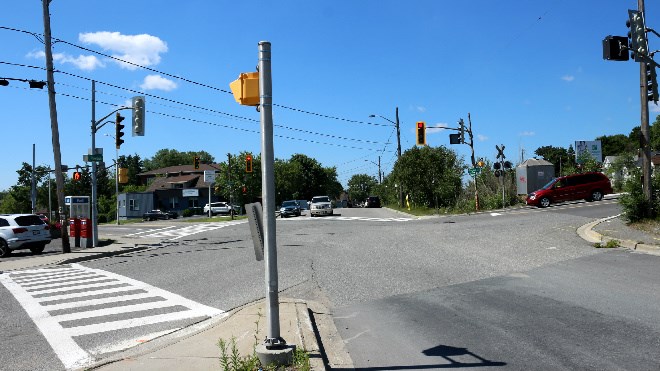An intersection in Sudbury known as Killer's Crossing needs more signage to make it safer, says a resident who has witnessed several near misses.
The intersection is where Regent, Ontario and Riverside meets left- and-right turning traffic from Lorne Street. Mark Palumbo says he uses it most days travelling to and from work. Recently, he saw a near-miss that prompted him to speak out.
"This is one of many times this has happened to me, where I've either witnessed cars almost getting hit or myself getting hit," he said. "Basically, a car coming down Lorne Street towards the downtown will turn right at Killer's Crossing and come through over the tracks and into the intersection against the red light.
"In this particular case, I had a green light and was travelling at about 50 km/h and I always look to the left, because I know this happens. Just then a pickup truck on my left came by and I slammed on the brakes and was able to avoid it. It wasn't really close, but if I hadn't been looking that way, I could have easily hit that truck."
Palumbo says it's not a matter of people ignoring the rules, it's that the intersection is complicated and tough to traverse for someone not familiar with how it works.
"When you're turning off Lorne Street, you've got a green light and make the turn, right away the road dips down. So you don't see the red light, which is across the road,” he said. "If you beep your horn, they get startled. They don't think they've done anything wrong. They look very confused."
He suggests moving the light so it's more visible to drivers coming off of Lorne.
"It's not people trying to do do this, they're not going through the red light on purpose against the law,” Palumbo said. “It's just very unclear to new people coming into town especially, and even for other people who don't use that crossing too often. At least four times there, I've witnessed a close call."
Tony Cecutti, the city's GM of infrastructure, said the root of the problem is the way the intersection developed. The area is one of the oldest in the city, and the rail tracks were there before any roads were built.
"Following that, with the development of the community, came the roads that served the homes that built up around the railroad tracks," Cecutti said. "It was very common in most cities to have roads on both side of the tracks, running parallel to each other, with crossings at various locations."
Killer's Crossing remains one of the most complicated in Canada, he said, and was one of the first to have traffic lights. In the last few years, Cecutti said there have been fewer accidents there than at other intersections in Greater Sudbury.
"There was a period of time in Sudbury when that was an extremely busy intersection, if you go back to the days when you had the shift workers at Inco when there was 20,000 employees,” he said.
“Lorne Street had extremely high volumes and that intersection was extremely complicated during shift changes. And in the '40s and '50s, there was a street car system that went out that way, so you had the freight trains and a separate line for the street cars. That would have been even more complicated."
As it is, several different roadways converge at Killer's Crossing, not including the railway tracks.
"Most intersections that are complicated might have five points of access, and this one has eight," he said. "In addition, there's pedestrians that are crossing the intersection, that adds to the complexity.”
One of the bigger issues is people trying to turn left onto Lorne from Regent, which isn't allowed, he said. But out-of-town visitors using their GPS might not notice the signs.
"Occasionally we see that," Cecutti said. "But the collision history for the last three years is showing there's a trend toward fewer collisions. The intersection is fully computerized, so there's lots of control over it."
In 2015, there were 14 total collisions -- none of which were fatalities – compared to 2013, when there were 20.
"There's rear ends and sideswipes and angle collisions of various types,” he said. “On the Lorne Street side, there was 10 various types of collisions, and on the Ontario side, four."
Cecutti said the intersection is functioning well with the digital traffic lighting they have in place, which works on automated timers to handle traffic.
"We're aware of the complexities, so there's lots of lights to help guide you through there," he said.
While Killer's Crossing is a challenge, Cecutti said there are lots of challenging intersections in that area, such as Martindale Road, Frood Road and Elm Street.
"We're used to this kind of complexity,” he said. “When we design our intersections, we have automated systems and staff that are, in my opinion, among the leaders in Canada in terms of understanding how these things work.
"That's part of the advantage of having so much complexity is you get a lot of practice at how to work with them."
